| May 20, 2008 |  |
MarsDaily Advertising Kit |
| Previous Issues | May 19 | May 16 | May 15 | May 14 | May 13 |
Phoenix Probe Due To Touch Down On Martian Surface London, UK (SPX) May 19, 2008
London, UK (SPX) May 19, 2008NASA's Phoenix Mars Lander is due to land on Mars this month (May) where it will probe the arctic landscape searching for conditions favourable for past or present life. UK scientists from Imperial College London and the University of Bristol are involved in the mission and will be based at the University of Arizona's Science Operations Centre on landing day where they will be part of the ... more LIDAR Detector Will Build Three-Dimensional Super Roadmaps Of Planets And Moons  Rochester NY (SPX) May 16, 2008
Rochester NY (SPX) May 16, 2008Technology that could someday "MapQuest" Mars and other bodies in the solar system is under development at Rochester Institute of Technology's Rochester Imaging Detector Laboratory, in collaboration with Massachusetts Institute of Technology's Lincoln Laboratory. Three-Dimensional "super roadmaps" of other planets and moons would provide robots, astronauts and engineers details ... more Mars Reconnaissance Orbiter Finds Interior Of Mars Is Colder  Pasadena CA (JPL) May 16, 2008
Pasadena CA (JPL) May 16, 2008New observations from NASA's Mars Reconnaissance Orbiter indicate that the crust and upper mantle of Mars are stiffer and colder than previously thought. The findings suggest any liquid water that might exist below the planet's surface, and any possible organisms living in that water, would be located deeper than scientists had suspected. "We found that the rocky surface of Mars is ... more Phoenix lander set for May 25 touchdown on Mars: NASA  Washington (AFP) May 13, 2008
Washington (AFP) May 13, 2008A US space probe sent to Mars to dig for signs of life is nearing the end of its nine-month voyage and should touch down on the Red Planet on schedule, NASA said Tuesday. The Phoenix Mars Lander, which blasted off from Cape Canaveral last August, is on course to reach the planet on May 25, where it will attempt to make a hazardous descent onto the Martian surface. "This is not a trip to ... more Phoenix Ready For Northern Mars Polar Landing  Washington DC (SPX) May 15, 2008
Washington DC (SPX) May 15, 2008NASA's Phoenix Mars Lander is preparing to end its long journey and begin a three-month mission to taste and sniff fistfuls of Martian soil and buried ice. The lander is scheduled to touch down on the Red Planet May 25. Phoenix will enter the top of the Martian atmosphere at almost 13,000 mph. In seven minutes, the spacecraft must complete a challenging sequence of events to slow to about ... more |
mars-water-science
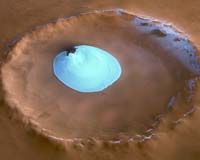 mars-phoenix 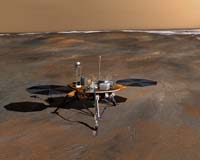 mars-mers 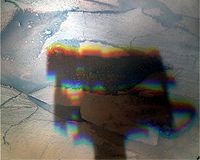 |
 Pasadena CA (JPL) May 14, 2008
Pasadena CA (JPL) May 14, 2008NASA's Phoenix Mars Lander is preparing to end its long journey and begin a three-month mission to taste and sniff fistfuls of Martian soil and buried ice. The lander is scheduled to touch down on the Red Planet May 25. Phoenix will enter the top of the Martian atmosphere at almost 21,000 kilometers per hour (almost 13,000 mph). In seven minutes, the spacecraft must complete a challenging ... more Phoenix Landing Area Viewed By Mars Color Imager  Pasadena CA (SPX) May 13, 2008
Pasadena CA (SPX) May 13, 2008NASA's Phoenix Mars Lander is scheduled to land on the Martian northern plains near 68 degrees north latitude, 127 degrees west longitude on May 25, 2008. In preparation for the landing, NASA's Mars Reconnaissance Orbiter has been monitoring weather in the region around the landing site. On April 20, 2008, the orbiter's Mars Color Imager camera captured this view of a large region of northern Ma ... more Intense Testing Paved Phoenix Road to Mars  Pasadena CA (JPL) May 11, 2008
Pasadena CA (JPL) May 11, 2008When NASA's Phoenix Mars Lander descends to the surface of the Red Planet on May 25, few will be watching as closely as the men and women who have spent years planning, analyzing and conducting tests to prepare for the dramatic and nerve-wracking event known as EDL - Entry, Descent and Landing. For after all their hard work, they know that landing on Mars is not a walk in the park. Less ... more Exploration Scientist Joins The NASA Space Race  Canberra, Australia (SPX) May 12, 2008
Canberra, Australia (SPX) May 12, 2008CSIRO and NASA are collaborating to develop exploration technologies currently used by the Australian minerals industry, for use on the Moon and Mars CSIRO Exploration and Mining scientist, Dr Brent McInnes - who recently worked at the NASA Goddard Space Flight Centre - says there is huge potential for US-Australian collaboration in lunar and planetary exploration technology. "My work with ... more |
mars-mers
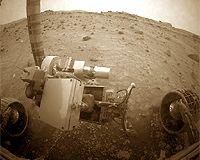 mars-phoenix 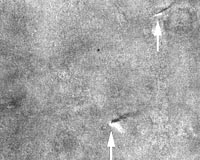 mars-mers 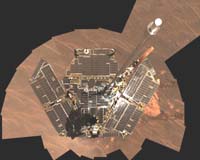 |
 Moffett Field CA (SPX) May 06, 2008
Moffett Field CA (SPX) May 06, 2008Between three and four billion years ago, Mars was a lot like Earth. Both planets are believed to have had surface water. Those similarities make it a prime candidate for extraterrestrial life. "The assumption is that if bacterial life emerged on Earth at that time, then why not on Mars?" says Soon Sam Kim, principal member of technical staff at NASA's Jet Propulsion Laboratory. Mars may a ... more Spirit In A Catch-22: Stay Awake Or Sleep  Pasadena CA (SPX) May 06, 2008
Pasadena CA (SPX) May 06, 2008Spirit's Tau measurements of atmospheric dust have remained steady, but solar array input has dropped a bit to 235 watt-hours per sol. Spirit still has enough energy to squeeze in Moessbauer studies of iron-bearing minerals at a time of year when the rover's handlers expected Spirit to be concerned only with survival. At present, the rover's target of scientific interest is a soil exposure ... more Glaciers Reveal Martian Climate Has Been Recently Active  Providence RI (SPX) Apr 30, 2008
Providence RI (SPX) Apr 30, 2008The prevailing thinking is that Mars is a planet whose active climate has been confined to the distant past. About 3.5 billion years ago, the Red Planet had extensive flowing water and then fell quiet - deadly quiet. It didn't seem the climate had changed much since. Now, in a research article that graces the May cover of Geology, scientists at Brown University think Mars' climate has ... more New Online Map Reveals Evidence Of The Forces That Once Shaped Mars  Laurel MD (SPX) Apr 30, 2008
Laurel MD (SPX) Apr 30, 2008A new online map lets visitors explore Mars' past through a collection of high-resolution observations from one of the most powerful spectrometers ever sent to the Red Planet. Evidence of ancient bodies of water, flowing rivers and groundwater peeks out from beneath layers of hardened magma and dust -- testaments to Mars' progression through wet, volcanic and dry eras. The data come from ... more
|
marsexpress
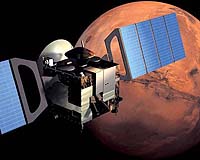 mars-general  mars-water-science 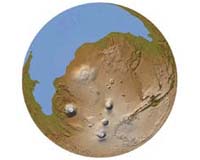 |
| Previous Issues | May 19 | May 16 | May 15 | May 14 | May 13 |
| The contents herein, unless otherwise known to be public domain, are Copyright 1995-2007 - SpaceDaily. AFP and UPI Wire Stories are copyright Agence France-Presse and United Press International. ESA Portal Reports are copyright European Space Agency. All NASA sourced material is public domain. Additional copyrights may apply in whole or part to other bona fide parties. Advertising does not imply endorsement, agreement or approval of any opinions, statements or information provided by SpaceDaily on any web page published or hosted by SpaceDaily. Privacy statement |